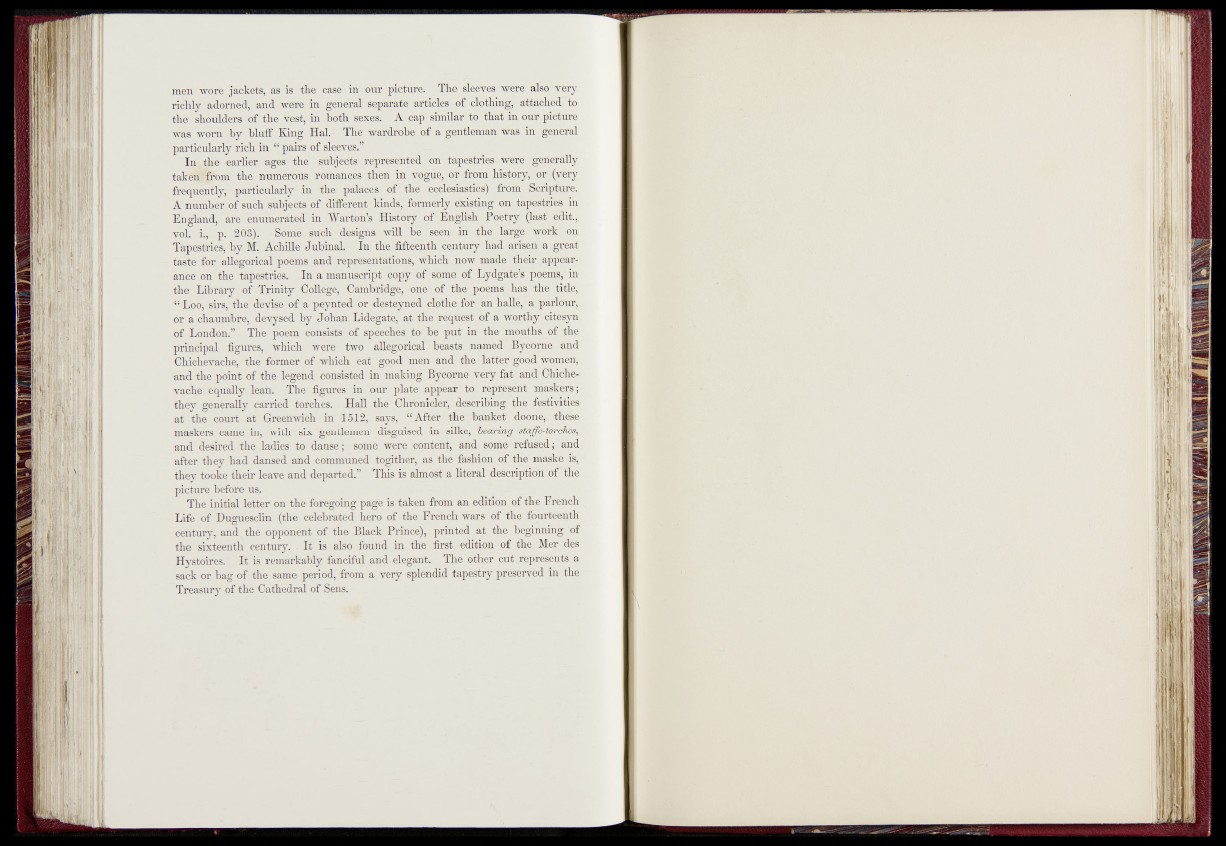
meh> wore^jackel a- > i-< jm '" ip pii m m 11H B B mk
richly aclorned,, and were in general scrarate J£mtlïï%j-‘~clôthjng,- ytfâcfjhd; to
"tfÿ-'shoulderâ <|p%*vest, in .totH';s^,e^ A cap similar5 to tIiauiaE^ p iq .ture
was worn ^by"bluff T^irig H a l . w a r d r o b e ‘ofJa'-gentleman, was ip ^ n c ra l
^&tiéularly rich in “ pairs of sleeves.”
In Ae earlier ages|t^Esùl)jccts feprfeseaited' on tapestries;
taket§j|fom the numerous ^ roinana s ^ ^ ^ n 5yQgue/or from ..history," ®^y|ry
'fre q u ^ ^ rî particularly in the palaces’-©ff| be ecclesiastics) from S c rM ^ .
A number bf smfeuhjoots of d i r e n t kinds,-formerly Existing on tapestries, in
England,- are enümpipae|e’cL in Wartoifs History of Engl^m JPq^tr^,,(lâst^^xt.,
'gnl .1 - mieh^ 8H ^ h n& foe seen in -the large work E t
Tapestrie^hy M. Achille Juhinal. In the fifteenth Century haJjoj|en a g£feat
taste for 'afiegoricâT^oems andrrepresentations, which.nôw made7 tbeiMaramir-
ance (&lfl%‘tapestriés. In a manuscript'copy of sème of Lydgate, sfpoeiri?," in
the -Library of Trinity Colleges Cambridge, -o ^ ,o f |g e . poems liasMj^ffiLle,
*‘Loo, sirs, .thff deviser of" a peynted or cfesteyned dotheforan halle, ’ a parlour,
or a chaumbréj devysed by Johan Lidegate, at ‘.the:Request of a ^OTÜis^OJ^im
Of London." The poem .consists of speeches to he put ïn Jh^jKsioujh«» Æfeer
principal .figures, which, were two allegorical beads nainçd Jlycp^ g
Chiehevache, the former of ,which eat “good, men and tile - latter ^ood^w^Tnpn,
and the poinbof.-the legend consisted nT making Bycorn«
vache equally lean. The figures in our plate appear m
they generally carried torches. Hall the Chronicler, de-sr
at the court at Greenwich in 1512, says, “After the Banket ^^m^^hese,
maskers camé, in, with-six gentlemen disguised in silke, learin
and desiredrthe-ladies to danse; some were canhrij m 1 - m 1
after they had dansed and communed togither, as thejashim of the ma she
they tooke their leave and departed.” This is almost a literaJ'^eschlptioh^Xtlie
picture before us. .
The iriitifll letter on the foregoing page is taken from an edition olpn|§French
T.ifPr of Duguesclin -(the. celebrated hero of the French.wars ofjthei^nrtee^th
çeîitùry, and the opponent of the Black Prince),'printed at the beginningjof
the sixteenth century. - It'is also found in the first edition of the Mer;d|3
Hysto ires.It is remarkably fanciful and elegant. The jother.cut Represents,a_
sack or bag of the same period, from a very splendid tapéstry preserved incthg
Treasury of the Cathedral of Sens.